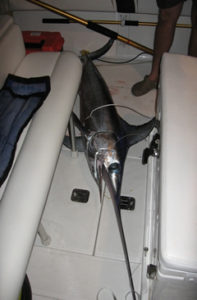The Atlantic Swordfish! Here are some tips to catch them off the Virginia Coast.
As most saltwater anglers are aware, a magnificent creature patrols the depths of the ocean waters off our Mid-Atlantic coast. This fish is most certainly a silhouette of power, grace, and remarkable distinction. Appropriately earning the title, “gladiator of the deep,” those who tangle with this beast can attest to its shear might and determination. While no stranger to our waters, a rekindling of interest inspired by a smattering of recent recreational catches has the dynamic Atlantic swordfish reemerging into the spotlight. At the very least, swordfish are beautiful, interesting entities with a dynamic history.
The Atlantic Swordfish

The swordfish exhibits a striking appearance, sporting a stout, rounded body overshadowed by an extra long, flattened bill, thus its namesake. As voracious nocturnal feeders, their large black eyes and blackish-brown color make swordfish perfectly equipped for deep water and night time stalking.
These incredible fish are a pelagic species found world wide from tropical to temperate waters. They are considered one of the largest and fastest predators in the ocean, growing to massive sizes of up to 15-feet and over 1,400 pounds, with the current all-tackle world record sitting at 1,182 pounds. Pacific swordfish grow much larger than swordfish in other bodies of water, whereas in the Atlantic Ocean, the females generally reach a maximum size of around 700 pounds. Males are the smaller of the two sexes, rarely exceeding 300-pounds. Sexual maturity is usually expected from three to six years of age, and swords can live for up to 25-years.
Although much of their daytime is spent at depths ranging from 650 to 2,000 feet, it is not uncommon to find swordfish basking on the surface, which makes them easy targets for harpooners. Swordfish are known as very strong jumpers, often seen breaching high into the air which may be an attempt by the fish to dislodge external parasites, or perhaps to stun its prey.
The bills of these fish are an amazing feature deserving of great awe. This unique appendage differs from the bills of other billfish in that they are truly sword-shaped. This sword is as long as one-third its body length, pointed, and very strong and sharp, thus creating a lethal weapon. When handling these willful animals, any wrong move can be very dangerous with deadly consequences. Stories are told of irritated swordfish actually puncturing the planking of small boats with their bills during fateful skirmishes.
Where and When
The highly migratory swordfish are found throughout the world’s marine ecosystem, including the Atlantic, Mediterranean, Indian, and Pacific Oceans. Migration patterns are such that Atlantic swordfish tend to seek colder northern waters during the summer months and warmer waters farther south during the wintertime for spawning. Swords are found year-round in subtropical and tropical regions. Unlike other billfish, swordfish possess a unique ability to tolerate a broad range of temperatures, allowing easy transit through many temperate water conditions, lending to a wider distribution. With this unique tolerance, swordfish are also able to travel deep within the water column where temperatures may hover around freezing. Swords have a special anatomical adaptation allowing for this existence in such cold water. This anatomical feature consists of a bundle of tissue with a specialized vascular system which insulates and warms the brain, thus preventing brain damage due to rapid cooling during extreme vertical movements.
Predators
Swimming alone or in very loose aggregations, swordfish are mostly solitary hunters. These predators of the deep will feed at very deep depths, moving to the surface mostly at night in search of smaller fish such as menhaden, herring, mackerel, bluefish, hake, and butterfish. Sword in the north Atlantic, swords also prey on squid and other cephalopods.
Recreational Interest
Swordfish are a favorite sport fish dating back to the very beginning of the development of the sport fishing industry. The powerful fight and incredible table fare offered by these massive billfish make the swordfish a prized target among recreational anglers all over the world. In the mid 1970’s, the recreational catch rate climbed to new heights when anglers discovered that night-time fishing with lights was an extremely effective method for sword fishing.
When targeting swordfish in Atlantic waters, adhering to the recreational regulations is a must unless you are up to a hefty penalty. The daily limit for recreational anglers is one fish per person, with a maximum of three fish per boat. The minimum size is 47 inches, measured from the lower jaw to the fork length. A vessel permit for catching highly migratory species is required by the National Marine Fisheries Service when targeting these fish. Remember to report all swordfish catches to the NMFS within 24 hours of the catch, this reporting helps with data collection.
Commercial Interest
The commercial swordfish industry has a long history, and many nations contribute to the harvesting of swordfish for commercial purposes. Swordfish fisheries in the Atlantic Ocean rely mostly on long lines, although the fishery began as a harpooning industry. Long lines consist of a main line adorned with thousands of baited hooks, reaching lengths of up to 30 to 70 miles. These long lines are supported within the water column by a buoy system. Unfortunately long lines are indiscriminate, so by-catches of undersized swordfish and other marine species such as turtles and marlin are common.
In 1948, the world’s commercial swordfish harvest consisted of 7,000 tons of fish, and continued to grow steadily each year. The world harvest count in 1970 was up to 37,000 tons of swordfish. But that year, reports of high mercury levels in swordfish frightened many consumers, and prompted strict regulation of the sale of these fish by the FDA, causing demand to decline significantly. Once the FDA raised the acceptable level of mercury in 1979, and later updated its stance on mercury level enforcement, the fear of contamination subsided and swordfish harvests catapulted to counts in excess of 80,000 tons of fish per year. This massive harvesting created immense fishing pressure on the worldwide swordfish populations.
Management and Conservation
Management of the swordfish is no simple feat. Since these fish cross international boundaries, worldwide cooperation is crucial for successful management of swordfish. The organization responsible for the joint coordination of Atlantic swordfish management is the International Commission for the Conservation of Atlantic Tunas, or ICCAT. This organization consists of over 30 members, including the United States. In addition to ICCAT, the National Marine Fisheries Service supplements swordfish management actions domestically, ensuring continued compliance with ICCAT decisions.
In the 1980s, data suggested a severe decline in swordfish populations due to decades of heavy fishing pressure. In 1999, ICCAT introduced a 10-year recovery plan designed to rebuild the stock of north Atlantic swordfish. Aggressive monitoring and management efforts were implemented to encourage the recovery of the stock. The United States worked with the domestic and the international fishing community in a strong push to support the rebuilding plan through ICCAT, which included cuts in total swordfish catches and implementing measures to protect juvenile swordfish stocks by closing many nursery areas to fishing.
The recently introduced 2006 ICCAT swordfish data suggests that the north Atlantic swordfish fishery is almost completely rebuilt, and currently sustains low mortality rates. With this outlook, the NMFS is considering an adjustment in the swordfish management measures this year. The goal of this potential modification of the recovery plan is to implement management measures that will enhance opportunities for U.S. anglers to harvest domestic north Atlantic swordfish quotas with limited environmental impacts.
The Atlantic swordfish is an amazing being, casting a shining example of a successful global conservation effort.











 Views Last 7 days : 1334
Views Last 7 days : 1334 Views Last 30 days : 5003
Views Last 30 days : 5003